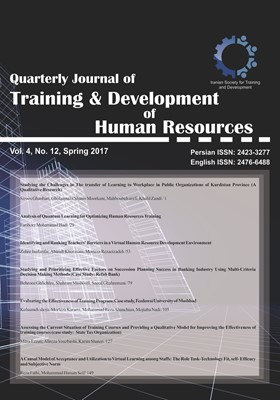-
-
List of Articles
-
Open Access Article
1 - Studying the Challenges in the Transfer of Learning to Workplace in Public Organizations of Kurdistan Province (A Qualitative Research)
Sirous Ghanbari gholamreza shams mourkani mahboobeh arefi khalil zandi -
Open Access Article
2 - Analysis of Quantum Learning for Optimizing Human Resources Training
fariborz mohammad hadi -
Open Access Article
3 - Identifying and Ranking Teachers' Barriers in a Virtual Human Resource Development Environment
Zohreh Jaafari far Abasalt Khorasani Morteza Rezaeizadeh -
Open Access Article
4 - Studying and Prioritizing Effective Factors on Succession Planning Success in Banking Industry Using Multi-Criteria Decision Making Methods (Case Study: Refah Bank)
Behrooz Ghlichlee Shahram Mashoufi Saeed Ghahremani -
Open Access Article
5 - Evaluating the Effectiveness of Training Program: Case study, Ferdowsi University of Mashhad
Kolsumeh Shojaa Morteza Karami Mohammad Reza Ahanchian Mojtaba Nadi -
Open Access Article
6 - Assessing the Current Situation of Training Courses and Providing a Qualitative Model for Improving the Effectiveness of training courses (case study: State Tax Organization)
Mitra Ezati Alireza Youzbashi Karim Shateri -
Open Access Article
7 - A Causal Model of Acceptance and Utilization to Virtual Learning among Staffs: The Role Task-Technology Fit, self- Efficacy and Subjective Norm
Reza Fathi Mohammad Hasan Saif
-
The rights to this website are owned by the Raimag Press Management System.
Copyright © 2017-2026







